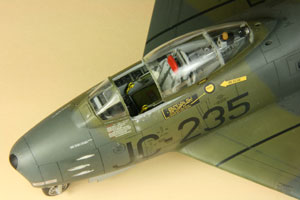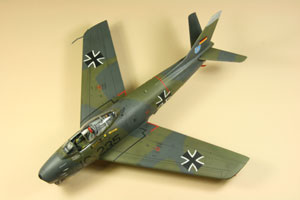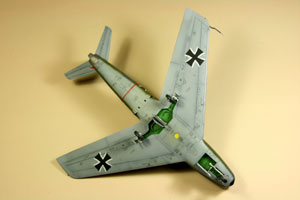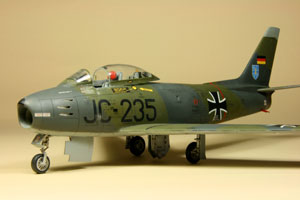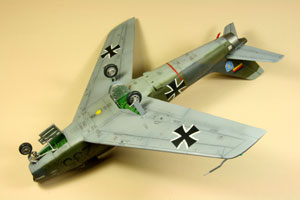|
|
The Sabre was one of the best jets ot its time.
Tried und tested in several conflicts, it received the
baptism of fire when matching against Mig-15s over Korea.
Developend by North American and first fielded by the USAF as F-86,
it was produced under license by a number of manufacurers.
One of the best variants was Canadar's, using their excellent Orenda engine.
These jets were the backbone of the fledgling German Luftwaffe in the
nineteen-fifties.
|
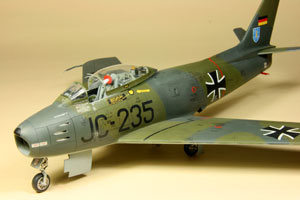
|
The Kit:
Revell recycled Hasegawa's offering, with a set of decals for Luftwaffe.
The quality of the kit is excellent, unfortunately Hasegawa's variant
(Mitsubishi produce) differs from the Canarair type used by the Luftwaffe.
While Revell includes corrected wing-tips in the kit, it mentioned with
not a word the differences concerning the different scoops and hoods on
the fuselage (not even thinking about the panel lines).
Initially I planned to build this model with Erich Hartmann's tulip, who
also flew this type, but after finding a set of decals (by Eagle Strike) for my old Luftwaffe
unit, the JG73, I decided to go for this variant (well, nostalgy)
|
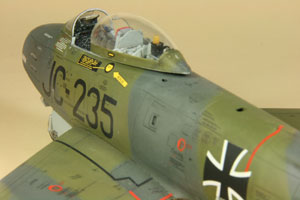
|
The Build:
The kit is a shake-and bake. Only tricky parts are the internal ducts of
the intake and exhaust, where the seams are difficult to sand. The wing-tips
have to be cut-off are replaced by resin-parts, which also only asks for
good putty and sanding.
The seat aksk for a pilot figure, which I didn't like, so I replaced it
initially by a part from the Italeri-kit. Painting went as usual:
Mr. Surfacer, Revell+Humbrol enamel, Future, Atist Oils, Xtra-Color Flat.
|
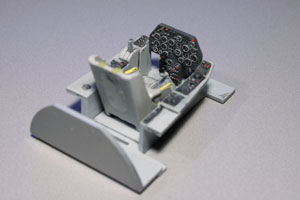
|
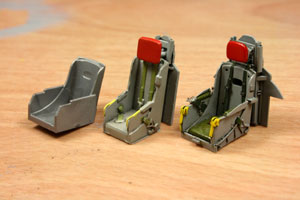 |
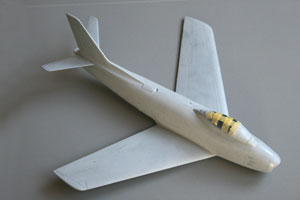
|
The Mod:
The modell came all nice, but somewhat boring. It was already finished,
but being happy with it, I decided for some desperate measures:
to open up the canopy and beef up the pilot's workplace.
For this purpose a CKM resin-set was used, which produced very good results.
Having finished the cockpit, I found out about the incorrect version of the kit.
After spending so much money and energy, I wanted it perfect, so I reworked a
number of scoops and fairings on the rear fuselage, as well as the panel lines.
There are four major features on the fuselage, which have to be corrected:
Flat panel on top, just before the vertical tail is to be removed
Square scoop on the right, on the bottom of the cross is to be removed
Square venting holes left and right just in front of the cross to be added
Air scoops are to be added left and right on the bottom of the fuselage
On top of these four items, a number of details and panel lines also deviate,
but these are not extremly conspicuous.
Despite initial concerns, the modification came out quite well, producing
now a historically correct, well detailed and appealing model.
|
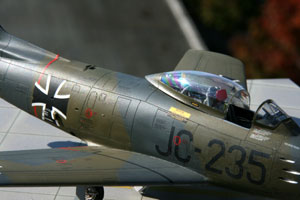

|
|
|
In Real:
Many Sabres are left in different museum or even in flying conditions:
This is a Canadair Sabre Mk.6, as shown in the Museum of Technology in Speyer.
While painted in the colors of the Golden Hawks, this is an original machine
used by the Luftwaffe. The very clean shape of the belly, as well as the telltale
air scoops of this variant are well visible.
|

|
|
This Sabre, found in the Museum of Chinese Aviation near Beijing is also
a jet initially used by the German Luftwaffe. After phasing out of the Luftwaffe
service, it was sold to Iran, who in turn forwarded the machine to Pakistan,
where it was used in the war against india. It still shows the Pakistani markings.
The serial number allows it to be tracked back to JG72 or JaboG42 froms Leck or Oldenburg.
It's operational codes in Luftwaffe use were JB-109, BB-178 and JB-124.
|
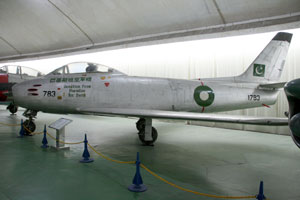
|
In Unreal:
Some sources claim, that the Sabre was strongly influenced by German
Aero-design concepts of Luft'46 projects. The initial Sabre
project of 1945 was delayed, till insight from German research could be
included, giving the Sabre its swept wings. Here's a side-by-side
comparison with the Focke-Wulf Ta-183 project.
|
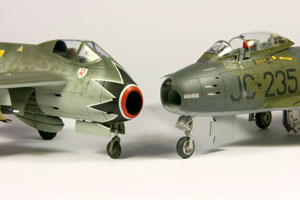
|

|

|
The result:
Taking all together, it requires a number of corrections to make
this a historically accurate model. This makes the build much more
difficult than its Japanese origin would promise. It's still worth it,
though - the other available models just don't offer the quality.
Still, it would be nice, if Revell didn't just add another sheet of decals,
but maybe some hints and an accurate drawing - after all, they added the wing tips.
In the end, this model has been awarded the silver in 48th scale on 2008th IPMS Netherlands in Utrech.
|


